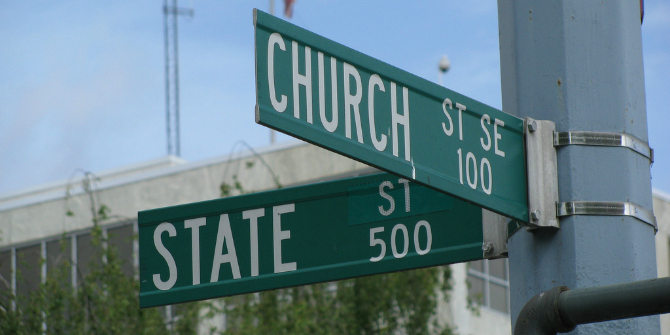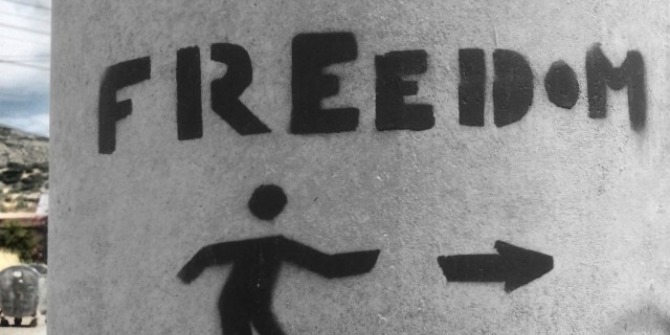 In Exporting Freedom: Religious Liberty and American Power, Anna Su contends that the US has promoted religious liberty alongside the expansion of its military and political power across the world. In this Book Review Forum, we present two reviews of Su’s new book, which were submitted separately and written independently.
In Exporting Freedom: Religious Liberty and American Power, Anna Su contends that the US has promoted religious liberty alongside the expansion of its military and political power across the world. In this Book Review Forum, we present two reviews of Su’s new book, which were submitted separately and written independently.
Exporting Freedom, Religious Liberty and American Power by Anna Su. Harvard University Press, 2016.
- Exporting Christianity: Why “Religious Liberty” Cannot Be Neutral Toward Religion – Gene Zubovich, Washington University in St. Louis
- How American power has also pushed American ideas about religious liberty – Megan Pearson, University of Southampton
Exporting Christianity: Why “Religious Liberty” Cannot Be Neutral Toward Religion
Gene Zubovich is impressed by the book’s range of case studies which span more than a century of US nation-building. While he praises the book’s depth, he also argues that greater attention to how the understanding of the idea of religious liberty has changed, especially in recent decades, would have enhanced its narrative.
The promotion of religious liberty is intertwined with the expansion of American military and political power abroad. This is Anna Su’s central contention in her brief and convincing account of the uses and abuses of religious liberty by politicians and military leaders in the United States. Her book, Exporting Freedom: Religious Liberty and American Power, focuses on the legal understanding of “religious liberty” as the United States conquered and rebuilt nations (in the Philippines, Japan, and Iraq) and helped develop international legal frameworks (the League of Nations, the Universal Declaration of Human Rights, the Helsinki Accords). Through an impressive range of case studies from the late 19th to the early 21st centuries, Su shows that state actors imposed a distinctly American view of religious liberty on a complicated global religious landscape.
Part of the difficulty the United States faced was in applying blunt concepts—free exercise and, especially, disestablishment—to a varied religious landscape. Before government officials could apply religious liberty abroad, they first had to render legible a variety of practices that stubbornly refused to comply with American expectations. For example, in the Moro region of the Philippines, folk Muslim practices combined ecclesiastical and political functions. American colonial officials transformed the Moro sultan into a religious leader and divested him of his secular authority. The Japanese emperor, who also embodied both religion and politics, became a secular political leader under the guiding hand of General Douglass MacArthur during the American occupation after World War II.
The practice of Shinto was considered a non-religious practice under Japanese law, akin to a civil religion. So American occupation forces had to first understand it as a religion before it could be disestablished. Similarly, Soviet Jewry needed to be imagined as a religious group before religious liberty could be extended to it (Jews were understood to be a nationality in the USSR). In these ways, the United States remade the world in its own image.
Exporting Freedom is an important, thoroughly-researched addition to the growing criticism of religious liberty. The term “religious liberty” normalizes and universalizes the assumptions of Protestant Christianity, several scholars have argued. It encourages policymakers to view conflicts as religious when they are also cultural, ethnic, and economic in nature. For these reasons and others, religious liberty is “impossible”, Winnifred Sullivan argues, and something we should move “beyond” according to Elizabeth Shakman Hurd. But Su stands out among this group of scholars in her optimistic insistence that “the laws on religious freedom can transcend the aims” of previous efforts (p.10).
Credit: Spyridon Kagkas (Flickr, CC-BY-SA-2.0)
Greater attention to the changing understanding of religious liberty over time would have added nuance to what is already a thought-provoking book. In Exporting Freedom, the meaning of religious liberty changes very little from the colonization of the Philippines in the 19th century to nation-building in Iraq in the 21st. Given the well-studied change in meaning of religious liberty in the US itself over the same time period, it is surprising that the idea remains so flat in the book’s narrative.
To better understand the changing meaning of “religious liberty,” it helpful to note that the vast majority of the decision makers Su discusses were members of ecumenical Protestant denominations, a small subsection of American Christians that became increasingly liberal in outlook during the twentieth century. This overrepresentation, which Su does not say much about, can be seen in the sheer number of Episcopalians discussed in Exporting Freedom, including Leonard Wood, Eleanor and Franklin Roosevelt, Douglas MacArthur, and Edward Stettinius, Jr.
This demographic overrepresentation ended by the 1970s, when more evangelicals and conservative Catholics and Jews were in positions of power. In broad terms, the defense and understanding of religious liberty passed from religious liberals to religious conservatives over the course of the twentieth century. Religious conservatives continued to insist on linking religious liberty to missionary activity, the inferiority of non-Christian religions, and a vociferous anti-secularism—ideas which had been largely discarded by religious liberals before the 1970s. This shift is central to understanding the changing meaning of America’s advocacy of religious liberty abroad.
It is worth questioning whether religious liberty can overcome its historical baggage, especially its anti-secularism. Given its historic ties to missionary activity, its use as a weapon by both presidents Franklin Roosevelt and Harry Truman against America’s irreligious enemies, and its embrace by the Christian Right in recent years, it is no exaggeration to say that “religious liberty” has always been intertwined with the goal of promoting religion.
In this light, it is no surprise that religious liberty has become the new mantra of the American Christian Right. Su is correct to observe that religious conflict across the world is an important concern today. But so is the tension between religious conservatives and their critics, both in the United States and abroad. For this reason, it is worth searching for a principle more capacious than religious liberty, which can protect religious minorities without mobilizing the state on behalf of religion. Perhaps it is time to retire the term after all.
How American power has also pushed American ideas about religious liberty
For Megan Pearson, the book provides illuminating insights into the US’ policies across seven episodes, from the Philippines in the late 19th century through the Cold War and to US’ current conflict with Islamic fundamentalism.
In Exporting Freedom Anna Su, an Assistant Professor at the Faculty of Law at the University of Toronto has written an extremely interesting book about the United States’ actions in promoting religious freedom abroad as part of its foreign policy during the twentieth century. She uses seven episodes across the century to illustrate this, from the US actions in the Philippines following the war with Spain in 1898, through the establishment of the League of Nations, to the Cold War and ending with Iraq and the problem of Islamic fundamentalism. In focusing only on the right to religious liberty, a right which occupies a prominent position within American political and legal thought, rather than human rights as a whole, Su is able to provide illuminating insights into the US’s attitudes and policy in each of these situations. This episodic focus also creates a snapshot of continuity and change in each situation and allows a number of themes to arise consistently throughout the book.
Firstly, there is the issue of what we mean by religious freedom. After all ‘religious freedom’ may be bit like motherhood and apple pie – no-one could oppose it, but that very popularity makes it a highly contested concept. Religious freedom to do what? And for whom? An individual right or a communal one? As the author states: “Although [Leonard] Wood [the Governor-General of the Philippines) believed in religious freedom, it was freedom that came in a particular size and shape” (pp. 32). To a greater or lesser extent this is true throughout. Its meaning is only made more complex, as she demonstrates, by the American emphasis given to the separation of church and state: a problem when this runs contrary to cultural views on the significance of a particular religion as the disparate examples of early twentieth century Philippines and post-war Iraq demonstrate. Is it an intolerable compromise to accept that the Iraqi constitution symbolically declares Iraq to be an Islamic nation if this does not affect the rights of non-Muslim minorities? If not, is this simply realpolitik, or a nation state’s legitimate understanding of religious freedom given its history and culture? As she demonstrates, it is possible to critique a one size fits all model without falling into incoherent cultural relativism. In a different context, that of post-WWII Japan, an even more fundamental issue of what counts as a religion at all is raised. Is state Shintoism a religion, and therefore conceptually entitled to protection or merely a dangerous promoter of nationalist ideology?
Credit: Rachel Patterson (Flickr, CC-BY-NC-SA-2.0)
A further theme is the American involvement in the juridification of international religious freedom and its change from being a mere matter of political morality to an enforceable legal right, culminating internationally in the UN Declaration of Human Rights and, more recently domestically through the US International Religious Freedom Act 1998 (IRFA). Su makes clear American ambivalence on this: of course such legal protection binds not only others but the US itself and therefore provides a mechanism for criticism and, on one view, an intrusion into state sovereignty. At times, as she notes, outright hypocrisy runs alongside this. After all the US may have been keen to promote religious liberty during the 1950s but it simultaneously refused to address internal racial discrimination.
Alongside these conceptual questions, Su weaves together the stories of domestic and international pressures. One such domestic change is the greater inclusivity of ‘respectable’, promotable, religion, from mainline Protestantism alone to the inclusion of Catholics and Jews, although as the recent popularity of Donald Trump demonstrates, there remain limits in some parts of US discourse. There are also other stories here, including the differences in opinion between different political actors such as the President and Congress, the influence of domestic public opinion on policy and the changing willingness of the US to become involved in international affairs.
While each of the episodes described has been dealt with elsewhere in more detail, this book is far more than the sum of its parts. Together they illuminate an under-considered aspect of America’s foreign policy and one which is only likely to become more prominent, given the seemingly intractable rise of Islamic terrorism.
Please read our comments policy before commenting.
Note: This article gives the views of the authors, and not the position of USAPP– American Politics and Policy, nor of the London School of Economics.
Shortened URL for this post: http://bit.ly/2ct8ejp
——————————————–
 Gene Zubovich – Washington University in St. Louis
Gene Zubovich – Washington University in St. Louis
Gene Zubovich is a Postdoctoral Research Associate at the John C. Danforth Center on Religion and Politics at Washington University in St. Louis. His research focuses on the history of US liberalism and religion in the 20th century.
_
 Megan Pearson – University of Southampton
Megan Pearson – University of Southampton
Megan Pearson is a Teaching Fellow at Southampton Law School at the University of Southampton. Her main areas of expertise are in Public Law, Employment Law, particularly Discrimination Law, and in Law and Religion.





